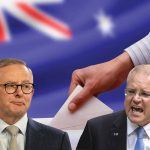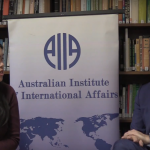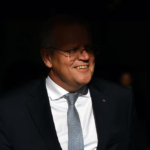Part 1 of 3. Why Tesla and 200,000 Australian auto workers need each other
Australia’s long history of building automobiles is coming to an end. Meanwhile Tesla’s electric cars are going from strength to strength. In this first of three blogs Stewart Nattrass argues that with vacant assembly lines and teams of experienced skilled workers we could enter a mutually beneficial relationship with Tesla.
Tesla has a very enviable problem. At the recent launch of the new model 3 Tesla, the CEO Elon Musk used an unprecedented sales and marketing campaign that has truly harnessed the power of the internet by capturing the surging global demand for clean technology transport. In fact, the campaign has been viewed by many as being too successful. It has created mass hysteria from the established car industry and critics as to whether the 400,000 pre-commitments of US$1,000 will indeed be taken up customers from around the world. Tesla now has a race on its hands to fill orders before they evaporate.
Elon Musk originally identified that his present car plant could reach a maximum capacity of 500,000 units per year in 2020, but has ambitiously revised this to be achieved by 2018. However, current model 2 Teslas have also to be taken into account from this figure. The first new model 3 is scheduled to roll off the production line in mid-2017 with potentially 100,000 being made by the end of 2017 (some 18 months away). The Chief executive recently took to Twitter to hint that many could be waiting beyond 2018 for their cars and that pre-orders will soon spill over into 2019 deliveries. There is the additional complexity of having to make both left and right hand drive models. Which countries will receive their orders first is anyone’s guess.
The pressure of trying to reach these extraordinary deadlines is taking a toll on the company. There have been recent resignations from high office holders within the organisation. The company is struggling to ramp up the financial, human and physical resources required to reach such daunting expectations.
In short, Tesla urgently needs additional manufacturing capacity to capitalize on these pre-orders and future orders. One set of tooling will probably produce 250,000 units per year (1 component every 2 minutes, 24/7, 50 weeks a year). They will need an additional manufacturing hub with a second set of tooling, with either left or right hand drive options.
Is this Australia’s golden opportunity?
Our car manufacturing industry, 90 years in the making.
As one of just 13 countries in the world capable of building a car from the ground up, Australia’s 90 year history of assembling and building automobiles is coming to an end. Successive governments have poured 10’s of billions of dollars into establishing and guaranteeing its survival. Unfortunately, the present government and the three incumbent car companies recently had a show of brinkmanship. Who won? We all know who lost.
In all 200,000 allied workers are expected to be looking for alternative employment. Prospects for that many jobs close to our cities, is virtually non-existent. Can we as Australians really afford to lose an industry that employs that many of us? We have all made bad decisions in our lives, ones that we wish we could replay and change.
Is there a way back, an alternative?
Australia’s car industry, on a world scale, is relatively small, however, in the new world of the electric car we are ideally positioned to be a major supplier. We have exactly what Tesla needs at exactly the right time. The whole Australian car manufacturing industry is closing down. In fact, Ford’s production lines in Broadmeadow and Geelong, Victoria, closes in October 2016 and both General Motors Holden and Toyota Australia finish production at their two plants by the end of 2017.
That means we have four vacant pre-existing assembly lines and the teams of experienced skilled workers ready to man them. We also have all the component and tooling suppliers with no forward orders. All prepared to prioritize the potential manufacture of Tesla cars.
Is Australia a viable country from which to manufacture and export?
Ford established that at $US0.78 to the AUD, Australia was a profitable place from which to export. Unfortunately, over the last decade the mining boom sent the AUD through the roof to be well above parity. This is the major reason that our Auto industry got into difficulties. The mining boom is now winding back and so is our currency to be presently around $us 0.72. Isn’t it possible to hedge our currency for a given amount for say 5 to 10 years and take the risk out of it? This requires experienced financial minds to debate the pros and cons.
We are also ideally situated to supply the Asia Pacific region (predominantly right hand drive countries). The ships that are bringing us the majority of our imported vehicles from Asia now are returning back empty. Isn’t this an opportunity to back freight at an opportunistic rate making us even more competitive? No matter from which continent the Tesla is produced they will have to be shipped around the world. There are also our new free trade agreements with China, Japan, Korea and the ASEAN countries, that will make us competitive exporters in our region compared with exporting from the USA.
Our present government’s position.
Tesla is fighting to establish itself as a serious player against the might and influence of the well established major car manufacturers of the world and the dominant position of the combustion engine. Tesla will need the help and support of a Government that is no longer beholden to the established car manufacturers. Isn’t that where Australia is right now? Can’t we get together on this?
The rhetoric of our present Government it that the future success of our nation is reliant on investing in innovative industries and the need to get in on the ground floor. It would take decades to invest and nurture a new industry that could employ 200,000 Australians. Wouldn’t it be smarter to rethink the use of all the infrastructure we already have?
The Australian Government has vast amounts of money available with which to entice Tesla should they choose. Previous Governments established a fund called the ATS which originally had $AUD 900 million dollars set aside to sustain the Auto industry in Australia until 2020. There is at least $500 million still remaining. Combine this with that the expected cost of retraining, redundancy and unemployment benefits, for 200,000 ex-workers (at least $2billion/year) and that’s 2.5 billion to start with. These soon to be vacant assembly plants are already constructed and with lay-outs for car assembly and expertly trained staff. This places us way ahead of the game when compared with starting from a greenfield situation.
How can we as individuals make this idea a reality?
Firstly, show the politicians that Australians didn’t support throwing our auto industry under a bus. Between elections voters have very few opportunities to express their disapproval of political decisions. In the lead up to the current elections politicians are very keen to tune into our thoughts to find key issues they think will win our votes.
Secondly, you need to show support for the idea of enticing Tesla to set up in Australia. Social media is a great forum to gather and measure support. Tesla of all companies knows that, they will pick up on whether we support the concept. Let’s show Tesla that Australia would invite them in with open arms.
Let’s get to work and share, like, re-post link-it tweet it and see if the idea can get some political attention before the upcoming election. I welcome your thoughts.
This article first appeared on LinkedIn and is republished with the permission of the author. Read the second and third blog.
Stewart Nattrass started out working in his family’s plastics company, winning innovation and small business awards and an Australian Design Award for his innovative design. Taking his product overseas his company won international product awards, stumping the world’s best tool makers as to how it was done. He later moved into the travel industry, building his own business up over ten years, expanding and positioning himself in a new industry. Stewart has empathy and affinity with the autoworkers affected, knowing firsthand what it’s like to re-engineer a new career and start again; twice. He wouldn’t wish that process on anyone, least of all 200,000 Australians.














